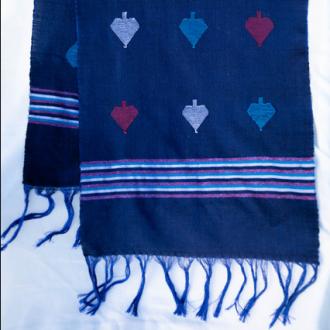
master floor loom weaver.
Jahar Ghalley is a highly accomplished floor loom weaver originally from Bhutan (Rodgers and Umunna 2017, Path to Empowerment, p. 24). She and her family spent 19 years in a United Nations-sponsored refugee camp in Nepal before resettling in Worcester in 2010. They lived for many years in an apartment in a triple decker in South Worcester. These large structures are Worcester’s iconic housing type for many newcomer families. The three apartments, one per level, are generally large with many windows and a porch for each floor. Jahar had set up her loom near a window in their first floor apartment, to catch the sunlight. Several other Nepali-speaking Bhutanese refugees lived in other triple deckers nearby. Some of the older women in these other households also wove textiles for sale through RAW. The older weavers would visit back and forth among the homes and all seemed to have an open-door policy for artisan friends and colleagues. In effect, they formed a weaving circle, sharing motif ideas and opinions about thread types and colors.
RAW directors Ellen Ferrante and Joan Kariko tried to provide the exact types of materials that these artisans preferred (usually thread bought directly from markets in Nepal as these artisans looked somewhat askance at American-made thread). Their fluid, open-border households in South Worcester had a muted but firm appreciation for community contact and also for Ellen and Joan’s labors in their regard.
Jahar, who is about 65 years old now, did not have the opportunity to go to school when she was a child back in Bhutan. Her family farmed and access to primary schools (especially for girls) was extremely limited. After fleeing the threat of Bhutanese national state government violence, Jahar and her kin arrived in the United Nation’s-sponsored refugee camp in Nepal with few possessions. They had been forced to leave their farms behind, which was traumatic. They saw the refugee camp with some relief but also trepidation. Nineteen years is a remarkably long time to wait for certification as official refugees so that they could enter a nation of resettlement as fully documented forced migrants. Many Bhutanese now living in Worcester were essentially “stuck” in the refugee camps for up to two decades.
While there, Jahar’s family needed income so she went to work in the camp’s craft workshop where she was paid on a piecework basis, textile by textile. She learned to weave on floor looms there and began to produce the standardized Bhutanese cotton textile whose colors and patterns are shown in (Figure X). Such weavings were sold by the camp staff to companies in Nepal to be cut apart and re-fashioned into men’s hats, called topi (part of the national Nepalese costume for men). Even in the highly regulated camp workshop, though (Jahar told us in a 2017 interview in her home) she was already experimenting a bit with using different thread colors. She liked to follow her own aesthetic preferences but the camp craft shop rules constrained her, back in the camp.
Once in resettlement in Massachusetts, in South Worcester, Jahar’s creative spark intensified through her collaboration with Refugee Artisans of Worcester (RAW). Once Jahar discovered that co-directors Ellen and Joan were happy to follow the dictates of the weavers as to thread types and colors and motif choices, Jahar’s weaving work became much more flexible in terms of color and motif structure and choice. When we interviewed Jahar in 2017 she was working on a midnight blue textile on her loom; nearby were stacks of some of her other cloths in yet other innovative colors. Several years after this Jahar developed a penchant for pastel colored threads. She followed that creative muse for awhile before returning to darker shades.
In Worcester, Jahar became well-known among the other Bhutanese weavers as an artisan of uncommon technical excellence. In fact, she served as a source of weaving advice for the other craftswomen. Her technical skills combined with her flair for inspired innovations led to her designation by the Massachusetts Cultural Council as a master weaver. Her textiles were also displayed at the 2015 Lowell, Massachusetts Folklife Festival, a juried show. These high honors pleased her a good deal; she knew that lack of’ a formal education can be stigmatic in America and so this sort of public recognition in Massachusetts for her art helped Jahar to overcome those negative stereotypes.
In a 2022 conversation with RAW’s Ellen and Joan about Jahar’s many contributions to RAW and the unusual quality of her weavings, Ellen told Susan Rodgers that Jahar is “a mercurial weaver.” Ellen meant this in a positive, appreciative way: Jahar is strongly influenced by new things she sees (new motifs, new thread types, unfamiliar yarn colors). Jahar pulls weaving ideas from these new observations and her textile repertoire grows in consequence. She usually did stay with fairly long, 25 inch wide textiles, which Central Massachusetts buyers could use as table runners or wall decorations. One time, Jahar wove an extraordinarily long cloth, too long to be sold, in fact. So, Ellen and Joan decided with Jahar’s approval to cut it up into pieces and make those into purses. They all got a good laugh out of that. Jahar was not a “traditional weaver” in any stilted sense at all.
June 2023 update: Jahar and some of her family have recently moved to Pennsylvania for new job opportunities and Jahar no longer weaves as much as she did when she and her family lived in South Worcester. Ellen and Joan hear that she has not set up her loom in her new home. Taking a broad view, we can say that textile hand-production at Jahar’s high level of excellence does seem to be an historically situational thing.

